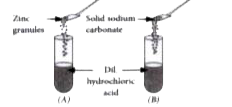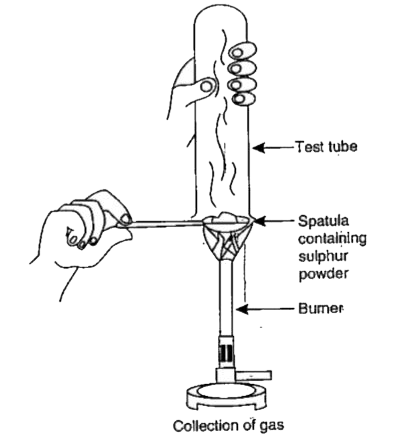Collect samples of some of the items such as copper wire, magnesium ribbon, sulphur powder and charcoal powder. Place these samples inside the separate test tubes. Now, add about 5 ml of dilute sulphuric acid to each sample. Observe if there is any reaction in each test tube. If not, gently warm the test tubes. Now, observe the reaction taking place.
Read the below question and try to answer them:
(a).When you observe a reaction in a test tube, bring a burning matchstick near its mouth. Could you hear a pop sound? What does this tell us about the reaction?
(b).When you repeat the experiment with dilute hydrochloric acid. Can You hear a pop sound on bringing a burning matchstick near these test tubes as well? What does this show?

Non-metals generally do not react with acids but metals react with acids and produce hydrogen gas that burns with a .pop. sound. You must have noticed that copper does not react with dilute hydrochloric acid even on heating but it reacts with sulphuric acid.
Related Playlists
- BOOK - PEARSON IIT JEE FOUNDATIONCHAPTER - METALS AND NON-METALSEXERCISE - CLASSROOM CORNER ( SUBJECTIVE TYPE QUESTIONS)9videos
METALS AND NON-METALS
- BOOK - PEARSON IIT JEE FOUNDATIONCHAPTER - METALS AND NON-METALSEXERCISE - CLASSROOM CORNER ( ASSERTION - REASON TYPE QUESTIONS)5videos
METALS AND NON-METALS
- BOOK - PEARSON IIT JEE FOUNDATIONCHAPTER - METALS AND NON-METALSEXERCISE - CLASSROOM CORNER ( MULTIPLE CHOICE QUESTIONS)28videos
METALS AND NON-METALS
- BOOK - PEARSON IIT JEE FOUNDATIONCHAPTER - Language of Chemistry and Transformation of SuubstancesEXERCISE - Concept Application Concept Application Level - 114videos
Language of Chemistry and Transformation of Suubstances
- BOOK - PEARSON IIT JEE FOUNDATIONCHAPTER - MOCK TEST EXERCISE - Question5videos
MOCK TEST
Similar Questions
Some materials like magnesium ribbon, aluminium foil, copperr wire and charcoal (powder) were taken in different test tubes labelled as P, Q, R and S. 5 mL of dilute hydrochloric acid was added to each test tube. When a burning matchstick is brought near the mouth of each test tube, in which cases pop sound would be heard ?
View SolutionSaloni took a piece of burning charcoal and collected the gas evoled in test tube.
Write down word equations of all the reactions taking place in the process.View SolutionWhen dilute sulphuric acid is added to granulated zinc placed in a test-tube, the observation made is :
View SolutionPiyush took sulphur powder on a spatula and heated it. He collected the gas evolved by inverting a test tube over the burning sulphur.
(b) Write a balanced chemical equation for the reaction taking place.View SolutionThe powder of a black substance taken in a test tube is treated with dilute sulphuric acid. The substance dissolves to produce a blue solution.
View SolutionA student took two test tubes, (A) and (B) containing 2 mL of dilute hydrochloric acid and added zinc granules to test tube (A) and solid sodium carbonate to test tube (B) as shown below:

The correct observation would beView SolutionA student takes some zinc granules in a test tube and adds dilute hydrochloric acid to it . He would observe that the colour of the zinc granules changes to
View SolutionPrateek took a piece of burning charcoal and collected the gas evolved in a test tube.
(a) How will he find the nature of the gas?
(b) Write down word equations of all the reactions taking place in this process?View SolutionSameer took sulphur powder on a spatula and heated it. He collected the gas evolved by inverting a test tube over it as shown in the figure.

Write a balanced chemical equation for the reaction taking place.View SolutionHarish took metal samples of Fe,Zn,Al,Cu and Pb in separate test tube. And added hydrochloric acid in each of them.
Write balanced chemical reaction with Al and Zn with dilute hydrochloric acid.View Solution

